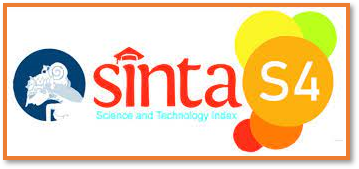Correlation between Depression, Anxiety, and Stress Levels with Spirituality Levels in Clients at the Narcotics Rehabilitation Centre Baddoka Makassar
Abstract
Clients undergoing drug rehabilitation are susceptible to mental health problems. However, this problem is not explored further in support of the assessment and treatment of clients, especially regarding depression, anxiety, and stress-related aspects of spirituality. The purpose of the study was to determine the relationship between levels of depression, anxiety, and stress with the level of spirituality in clients at the Baddoka BNN Rehabilitation Center. This research uses descriptive quantitative research with a cross-sectional study method. The total sample that participated in this study was 62 clients who underwent rehabilitation as much as the sample was taken using the purposive sampling technique. The instruments used are DASS 21 (The Depression, Anxiety and Stress Scale) to measure the level of depression, anxiety, and stress and DSES (Daily Spiritual Experience Scale) to measure the level of spirituality. The data analysis technique uses Chi Square test analysis. The results of the study obtained that there was no significant relationship between the level of depression and anxiety with the level of spirituality. However, the other results show that there was a significant relationship between stress levels and spirituality levels. The results of this study can be used as a basis for developing assessments, screening, and developing psycho-spiritual-based service interventions for counselors and service providers for clients in rehabilitation centers and other drug rehabilitation services.
Full Text:
PDFReferences
Antara News. BNN: Prevalensi pengguna narkoba di 2021 meningkat jadi 3,66 juta jiwa. 2022.
BNN. Data Statistik Penanganan Kasus Narkotika [Internet]. 2021 [cited 2022 Jul 7]. Available from: https://puslitdatin.bnn.go.id/portfolio/data-statistik-kasus-narkoba/
Baracz SJ, Everett NA, Cornish JL. The impact of early life stress on the central oxytocin system and susceptibility for drug addiction: Applicability of oxytocin as a pharmacotherapy. Neurosci Biobehav Rev [Internet]. 2020;110:114–32. Available from: https://doi.org/10.1016/j.neubiorev.2018.08.014
Ruisoto P, Contador I. The role of stress in drug addiction. An integrative review. Physiol Behav [Internet]. 2019;202:62–8. Available from: https://doi.org/10.1016/j.physbeh.2019.01.022
Niarti DW, Pamungkas MA, Nopitawati NM. Gambaran Tingkat Kecemasan Pada Warga Binaan. J Kesehat Madani Med. 2021;12(01):14–21.
Nawangsih SK, Sari PR. Stres Pada Mantan Pengguna Narkoba Yang Menjalani Rehabilitasi. J Psikol Undip. 2017;15(2):99.
Grant Weinandy JT, Grubbs JB. Religious and spiritual beliefs and attitudes towards addiction and addiction treatment: A scoping review. Addict Behav Reports [Internet]. 2021;14(November):100393. Available from: https://doi.org/10.1016/j.abrep.2021.100393
Rosmarin DH, Alper DA, Pargament KI. Religion, Spirituality, and Mental Health. Encycl Ment Heal Second Ed. 2016;4:23–7.
Ritt-Olson A, Milam J, Unger JB, Trinidad D, Teran L, Dent CW, et al. The protective influence of spirituality and “health-as-a-Value” against monthly substance use among adolescents varying in risk. J Adolesc Heal. 2004;34(3):192–9.
Galanter M, Dermatis H, Bunt G, Williams C, Trujillo M, Steinke P. Assessment of spirituality and its relevance to addiction treatment. J Subst Abuse Treat. 2007;33(3):257–64.
Ekawati FI. Hubungan Antara Keadaan Depresi Dengan Status gizi pada pengguna opiat di pusat rehabilitasi narkoba. Diponegoro University; 2009.
Vorspan F, Mehtelli W, Dupuy G, Bloch V, Lépine JP. Anxiety and Substance Use Disorders: Co-occurrence and Clinical Issues. Curr Psychiatry Rep. 2015;17(2).
Prosek EA, Giordano AL, Woehler ES, Price E, McCullough R. Differences in Emotion Dysregulation and Symptoms of Depression and Anxiety among Illicit Substance Users and Nonusers. Subst Use Misuse [Internet]. 2018;53(11):1915–8. Available from: https://doi.org/10.1080/10826084.2018.1436563
Stathopoulou G, Gold AK, Hoyt D, Milligan M, Hearon B, Otto MW. Does anxiety sensitivity predict addiction severity in opioid use disorder? Addict Behav. 2021;1:112.
Caniglia EC, Khan M, Ban K, Braithwaite RS. Integrating Screening and Treatment of Unhealthy Alcohol Use and Depression with Screening and Treatment of Anxiety, Pain, and Other Substance Use Among People with HIV and Other High-Risk Persons. AIDS Behav [Internet]. 2021;25(s3):339–46. Available from: https://doi.org/10.1007/s10461-021-03245-5
Ghaferi H Al, Bond C, Matheson C. Does the biopsychosocial-spiritual model of addiction apply in an Islamic context? A qualitative study of Jordanian addicts in treatment. Drug Alcohol Depend [Internet]. 2017;172:14–20. Available from: http://dx.doi.org/10.1016/j.drugalcdep.2016.11.019
Arévalo S, Prado G, Amaro H. Spirituality, sense of coherence, and coping responses in women receiving treatment for alcohol and drug addiction. Eval Program Plann. 2008;31(1):113–23.
Arnold RM, Avants SK, Margolin A, Marcotte D. Patient attitudes concerning the inclusion of spirituality into addiction treatment. J Subst Abuse Treat. 2002;23(4):319–26.
DOI: http://dx.doi.org/10.30872/j.kes.pasmi.kal.v6i1.10145
Refbacks
- There are currently no refbacks.
Indexing by :










